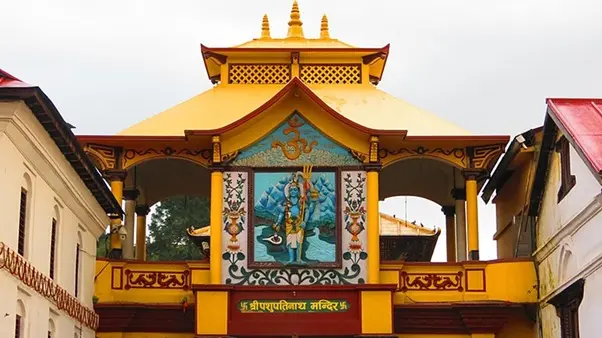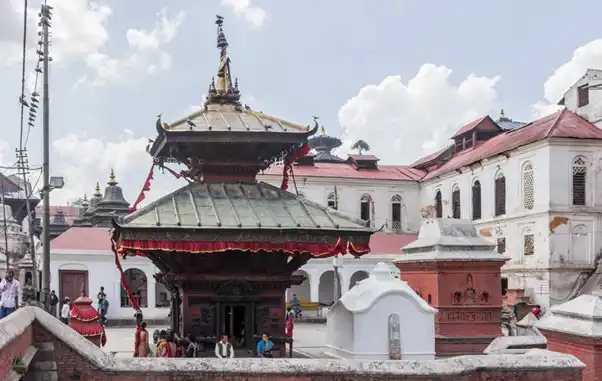The site , Pashupatinath Temple is situated by the side of the Holy Bagmati River, and it proves to be one of the best examples in order to indicate the spiritual character of Nepal. This majestic temple complex, having devotion to Lord Shiva who is the protector of all animals, is not just a leading religious place but also a genial architectural marvel that has held the attention of friends of god and tourers for ages.

A Sanctuary of Serenity
Similar to other myths, the history of the Pashupatinath Temple is as old as the legends that are being told along with it. Although it is obscured behind the veil of time, historical sources date a faith community to at least fifth century BC. The present main temple, a two-floor structure with a golden roof, was built in the middle of the 15th century CE, since it replaced the wooden buildings that had fallen victims to termites.
Architectural Splendor
The temple complex is a gigantic compound of more than 500 temples, ashrams, sculptures, and inscriptions. The main pagoda consists of the holy lingam that represents Shiva, which symbolizes the whole sacred place. The site which takes up an area of 246 hectares has mini temples and a main pagoda house that reflect the grandeur of the Nepalese craftsmanship.
The Deity and the Devotees
Pashupatinath is the oldest Hindu temple in Kathmandu and holds a special place in the hearts of the faithful. The deity here, Pashupati, is said to have gained great fame, and the temple’s existence dates back to as early as 400 CE. The temple is also one of the Paadal Petra Sthalams, revered sites on the continent for Shiva worshippers.
Festivals and Celebrations
The temple springs into life on the occasion of Maha Shivaratri festival, which chooses the beginning of spring and honors Shiva, the great night. The temple attracts even the most distant devotees who come here to receive blessings, and participate in a variety of celebrations such as fasting, singing songs for God, and offering praises.

A World Heritage Site
In 1979 UNESCO declared Pashupatinath Temple as world heritage site, applauding the temple for its universal value of culture and heritage. This allowed it to become part of the official history and avoid losing its historical meaning for the next generations.
Embracing All Life
The temple’s interior, which can accommodate Hindu visitors only, is forbidden to people of other faiths, but the rest of the complex is open to all. Pashupatinath is presiding over a spectrum of wild life on his land that includes deer, lambs and monkeys, for they all are under his protection.
The Final Journey
The core of Pashupatinath lies in its function of all phases of life including birth, life, death and rebirth. The river with its clean waters is the place for funeral pyres to be set up. This is because it is believed that being cleansed by the holy Bagmati River will lead to a better life.
Interesting Legends Associated with Pashupatinath Temple
The Pashupatinath Temple is associated with a number of tales which indeed make the Temple even more fascinating and intriguing.
The Linga of Light: The people say that Pashupatinath Jyotirlinga is the representation of the land itself, which consist of the highest completeness and the most powerful force. This sacred linga is seen as eternal – completely independent of any humans, as if it were created by nature itself.
Shiva and Parvati as Antelopes: One of the legends says Shiva and Parvati transformed into an antelopes and walked the forest on east bank of Bagmati River in the jungle. It was later that gods caught up with Shiva and held on to one of the horns, therefore making him again into a godly form. The horn was broken into pieces and worshiped as a linga but was again buried. Several hundred years later, a herdsman noticed his cow spraying the ground with milk at that spot, and after digging he found the divine linga of Pashupatinath.
The Protector of Animals: Also, according to his name, Pashupati is known as the protector of all animals and natural world. Correspondingly, bulls became to be associated with him representing prosperity and wealth. Shiva is, therefore, regarded as a deity of creation in his Pashupati manifestation.
The Half Shivalinga: The Pashupatinath Temple in Kathmandu is said to be the ‘half Shivalinga’, and the other half is in Kedarnath. Consequently, visiting Kathmandu prior to Kedarnath is considered a total Shivalinga visit.
Through these legends, we can appreciate the religious significance of the shrine and also observe the bond between the divine, nature, and the people who worship at the ancient site. The stories passed through the generations of Pashupatinath Temple, are still challenging and inspiring all the visitors who visit the Pashupatinath. This makes the Pashupatinath, a living scripture of faith and tradition.
How can I plan a visit to Pashupatinath Temple?
Pashupatinath Temple tour is a wonderful excursion into spirituality and cultural traditions of Nepal.
1: Travel Arrangements
Location: Pashupatinath Temple is placed in Kathmandu, Nepal.
Transport: There is no problem getting to Kathmandu as Tribhuvan International Airport is nearby. From there, the taxis are right there waiting for you to get to the temple.
2: Accommodation
Stay: Kathmandu has a wide variety of accommodation options, starting from budget hostels going up to the luxury hotels. You can think of staying very close to the temple if you want to be a part of the early morning or evening rituals.
pashupatinath temple entry fee
The entry fee for the Pashupatinath Temple varies depending on the visitor’s nationality:The entry fee for the Pashupatinath Temple varies depending on the visitor’s nationality:
Foreign Nationals: NPR 1000.
Indians: Free entry.
To get the most updated information it’s better to check the temple website or contact the temple authorities before you go as they are the most reliable source
3: Temple Visit Timings
Timings: The temple complex is open all days of the week. On the other hand, the inner sanctum is limited to Hindus alone. There is nothing like watching this place at the early hours of the morning or the end of the day when the aarti ceremonies take place.
4: Understanding Local Customs
Dress Code: Demonstrate modesty in dressing as a sign of respect for the religious arena. Do not wear skirts and sleeveless shirts.
Photography: Although photography is permitted in most areas, it is not allowed within the sanctuary of the main temple. Permissions should be always taken before taking photos of the Sadhus or rituals.
5: Exploring the Complex
Guided Tours: How about you hire a guide who is familiar with the area and find out more about the details and importance of each building at the complex.
Cremation Ghats: If you want to observe the cremation ceremonies, greet the people with respect. It is more of a private and reverent ceremony to the indigenous.
6: Festivals
Maha Shivaratri: Witness the temple in all its glory if possibly drop in during the Maha Shivaratri, the great night of Shiva.
7: Local Etiquette
Respect: Respect the worshippers and the holiness of the temple. It is a center of worship first and then a tourist attraction.
Donations: Giving to the temple, or the Sadhus is widespread but not required. Please feel free to do so.
8: Health and Safety
Health Precautions: Always stay hydrated and carry water with you. Besides that, watch out for the monkeys around the temple; they can be pranksters.
9: Departure
Leaving the Temple: After you leave, try to retain the presence of serenity of the Bagmati River as you recollect your adventure on the ancient site.
Keep in mind that though you can’t enter the main temple if you are a non-Hindu, there is still a lot to learn and experience in the complex. Every nook and cranny of Pashupatinath is a window into Nepalese culture and Hindu rituals.
Conclusion
The Pashupatinath temple manifests as more than just a place of prayers, being rather a sacred haven, in which the Nepali cultural heritage is concentrated in. Be it a high priest seeking for divine blessings or a visitor from other regions that come in search of history, architecture and soul of the nation at Pashupatinath temple, it takes us on an inner journey.
Disclaimer: The topic below, The Pashupatinath Temple‘s purpose is for well-known news article. Though the most significant efforts were exerted to obtain the best of the information, travel regulations, and local customs are variable, making many variances in entrance fees, timings, and access. The visitors are expected to confirm appropriate conditions and the advisory issuance first, to get ahead of any inaccuracies that might come up on the planned voyage. The author and publisher disclaim any form of liability for any form of reliance arising as a result of the information provided.
5 thoughts on “Pashupatinath Temple: Discovering the Divine”